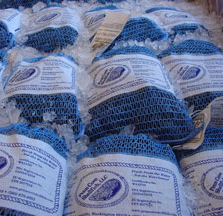Shellfish Care

There are different ways to take care of different types of shellfish. If you follow these methods, you will insure that the shellfish which you have will maintain its flavor and shelf life to the best extent possible. Just remember, the shellfish you have are alive, they are not dead protein like a fillet of fish, and you want to keep them alive until they are cooked or served.
Whether you are a commercial distributor or a home consumer, you should be holding the shellfish products you buy or sell in a refrigerated environment at 35-40 degrees Fahrenheit. The number one problem in storing shellfish is temperature abuse, or when they are allowed to get warm, so keep your shellfish cool, this also slows down their metabolism which will keep them fresh tasting longer.
If you are a home consumer or restaurant, your shellfish may have been given to you in a plastic bag, if so, make sure that the top of the bag is open or that there are holes in the bag to allow the shellfish to breath, remember, you are trying to keep them alive!
The next important part of the storage equation is ice.
Whether you are a food service user, wholesale distributor or a home consumer, you should store shellfish as follows:
Mussels
They should be placed in a self draining container and covered with ice and then placed in the cooler. The container needs to be able to drain off the melted ice so that the mussels do not drown in the stagnant water.
At the restaurant or at home use either a self draining bus tub or a colander placed into another bowl underneath it, with the mussels covered with ice placed in the self draining container.
Wholesale distributors should remove their bags of mussels from the shipping boxes in order that they get some air, and then bury the bags in a tote of ice, with the plug pulled from the tote so that the ice water may drain off. Be sure to leave some of the tags of the bags showing so that you may rotate your stock properly. Saltwater ice may be too cold for the mussels and cause some to freeze, so stick with freshwater ice.
Clams and Oysters
Clams and Oysters should be placed on ice and covered with a damp cloth towel or burlap sack and then stored in the cooler. Do not bury the clams and oysters in the ice as you would the mussels. At home or in the restaurant, you may simply store the clams and oysters in the refrigerator in an open container, but be sure to cover them with a damp cloth in order to keep the refrigerator fan from drying them out.
You may check on the viability of the shellfish by smelling it and looking to see if the shells are closed. If the product smells fresh, like the sea it is probably great, if it smells funky, think about discarding it. Then sometimes the shells of mussels, clams and oysters will gape open just a bit in order to get some more air, so if you see this, and are wondering if they are still alive, simply squeeze them shut, and if they try to close on their own, they are still alive and OK, however, if they spring right back open again, discard those that will not try to close. Do not under any circumstance cook or freeze dead shellfish for later use, as they will cause you or your guests or customers gastrointestinal problems.
